By now you would have realised that this is the second variation of saheena that we prepare. This saheena recipe is easier than the first because of the steps and the preparation but the cooking time may probably be the same since in this saheena recipe we have to leave the mixture to “rest”.
The Two Types of Saheena
Everyone will have a liking for one of the two types for me I will have to stick to liking both. It depends on the mood I’m in or how hungry I am at the time. 🙂 The roll up type I like because of the ratio of dasheen bush to split peas powder and vice versa.
It’s been great posting all these recipes for Divali. I actually pulled it off: I posted five recipes in two days. To me that’s a feat in itself seeing that I usually post only three a week. Yawn! Sleep is near….enjoy this second mouthwatering and delightful variation of Saheena.
Saheena Recipe
Saheena
Ingredients:
6 dasheen leaves ( stems removed)
1 teaspoon saffron powder
1 tablespoon baking powder
2 teaspoons yeast
1½ cup split peas powder
2½ cups flour
2 teaspoons salt
4 tablespoons green seasoning
2 cups water
few drops of lime juice
Direction:
Fold the leaves and cut off where the stem joins to the leaf. Then cut the dasheen leaves finely.
Add the rest of ingredients….
Note: Don’t forget the lime juice or else it will itch!
and mix thoroughly. Leave to rest for ½ an hour.
Heat the oil over a medium flame.
Have a small bowl of water nearby. dip your hands in the water then pick up a bit of the dough and spread with your hands.
Fry until golden.
Drain and serve with favourite kuchela or chutney.
Some Facts about Dasheen Leaves
Dasheen (its scientific name is Colocasia esculenta) is an edible plant. You can learn more about this plant by following this link. of taro plant. However, In its raw form, the dasheen should not be eaten as it is toxic. The presence of calcium oxalate and raphides in the plant cells. However, these oxalates are minimized once the plant is cooked.
Some people however, may have to avoid eating foods with a high oxalate content if they are at risk for developing kidney stones, as oxalates contribute to the formation of kidney stones. Younger leaves contain more oxalates than older leaves. Oxalates is common in many other types of leafy foods, but most are very low. For foods high in oxalates, they must be cooked until soften. Another method is soaking the leaves in cold water for at least 30 minutes or overnight. So for those that you enjoy eating raw, soak them before you consume them.
Some other foods high in oxalate are soy milk, soy beans, sweet potatoes, tofu, tea (black), wheat bran, cranberries, chocolate, beer, oranges, nuts and beans.
The leaves and stem are nutritious. They are low in calories, but high in fiber content. One cup of cooked dasheen leaves will give you the following: vitamin C and polyphenols (antioxidants), vitamin A, potassium, folate, calcium and iron. The leaves contain high levels of antioxidants, to help reduce the damaging effect of free radicals. Free radicals can cause inflammation in the body and in turn cause other diseases such as heart disease, autoimmune disorders, and cancer.
So ends another fine East Indian recipe and my posts for the day. Hope you enjoyed them and of course Happy Divali to the Hindu community from Simply Trini Cooking. 🙂
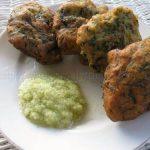
Saheena II
Ingredients
- 6 dasheen leaves stems removed
- 1 tsp. saffron tumeric powder
- 1 tbsp. baking powder
- 2 tsp. yeast
- 1 1/2 cup split peas powder
- 2 1/2 cups flour
- 2 tsp. salt
- 4 tbsp. green seasoning
- 2 cups water
- few drops of lime juice
Instructions
- Fold the leaves and cut off where the stem joins to the leaf. Chop the dasheen leaves finely. Add the rest of ingredients.
- (Note: Don’t forget the lime juice or else it will itch!). Mix thoroughly. Leave to rest for 1/2 an hour.
- Heat the oil over a medium flame. Have a small bowl of water nearby. Dip your hands in the water, then pick up a bit of the dough and spread with your hands.
- Fry until golden. Drain and serve with kuchela or chutney.
By the way, The Simply Trini Cooking Cookbook is now available at Amazon in Kindle and soft cover paperback copy. The cookbook contains over 600 recipes. Order your copy today!

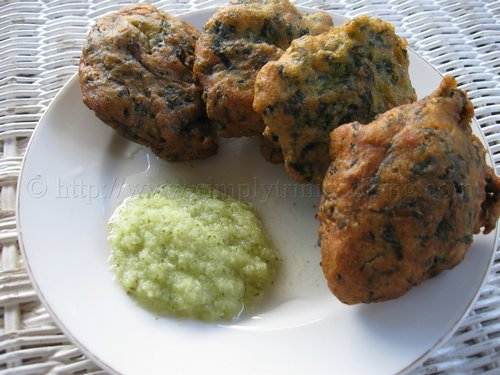
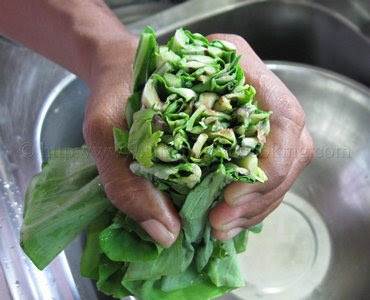


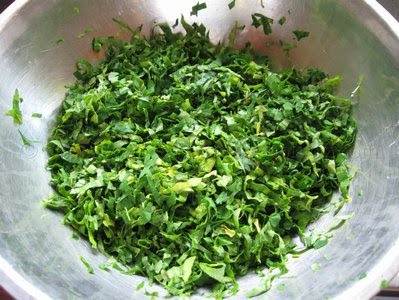
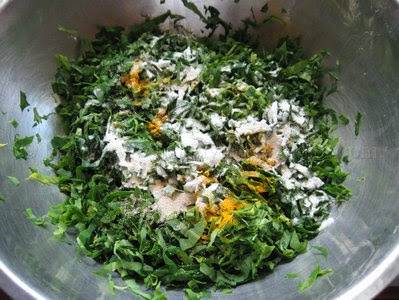
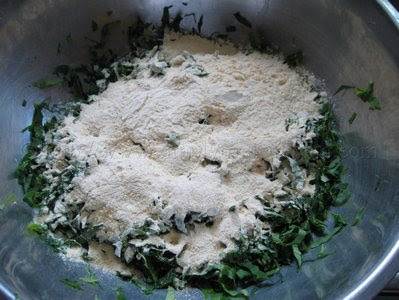
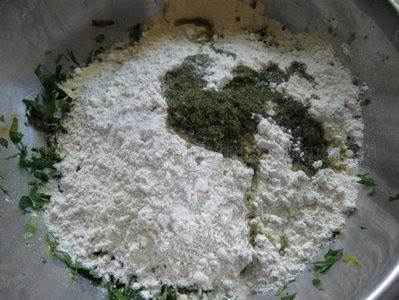
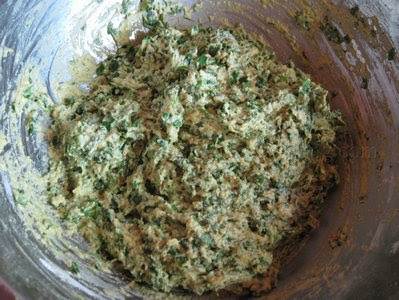
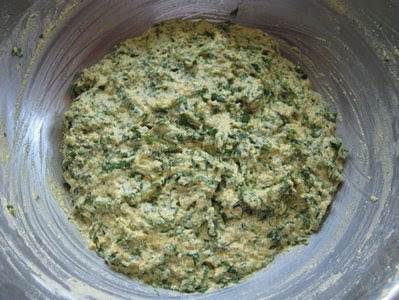




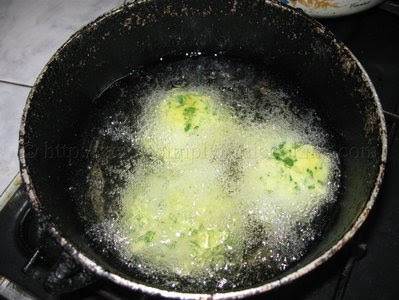
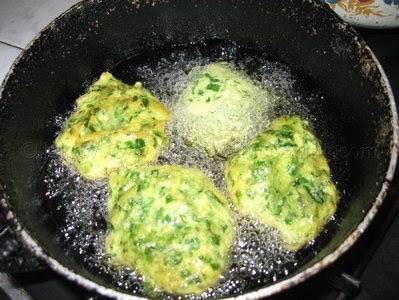

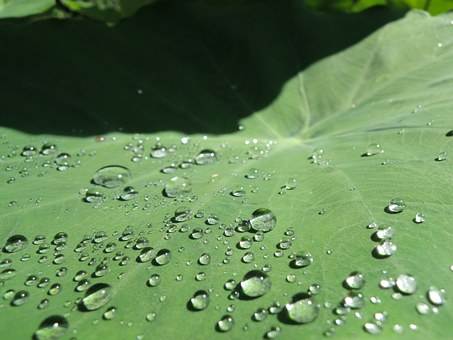
i have to go find out the leaves…i am craving for this now…though we make it a bit differently..
I would like to see how you all make it!
whew – 5 posts in 2 days. I am lucky if I get 5 in one month 😀 dedication, boy!
the older generation in my village call this one bhaggia, but that name didn’t seem to make it into the popular terminology in Trinidad. Instead we have “roll-up Saheena” and “cut-up Saheena” – has its own rhythm I suppose!
Chennette girl it was a feat in itself but now I’m tired. Of course I have to make sure and post for next week. The work never ends but it is enjoyable. 🙂
Hi Felix,
Great recipes… keep posting.. we had a good Diwali
what could i substitute for dasheen or callaloo?
is trini callaloo the same as jamaican calalloo? (the plant variety)
Jamaican calalloo is what we call amaranthus (see the dasheen bush bhaji recipe).
Well Sebastian, I believe I may have to clarify a number of things first. To us, calalloo is a dish, and dasheen bush (also referred to as taro leaves) is the main ingredient in this dish, as well as in the saheena dish.
However, some people have substituted spinach leaves in place of dasheen bush in the callaloo dish (I believe the Jamaicans do this as well). I guess you can borrow this idea as well for Saheena I and II if you really want to try the dish and can’t get dasheen leaves.
I was wondering where I would get Dasheen leaves from so being able to use spinach leaves is good to know.
This recipe sounds very tasty. I think you did an amazing job on getting all the recipes completed in such a short time. Well done
Wanda
http://www.only-cookware.com/
Thanks Wanda 🙂
Hey Felix:( I tried making the saheena today but initially I suspected I measured the flour wrong when it looked a bit runny so I added some more flour. I dont know if this is the cause of my probs but when I fried the saheena it quickly cooked on the outside but inside was very raw:( I tried frying very small bits but to no avail:( plsss help me:(
Hmmm! You suspected…Probably you did 🙂
When cooking many things could go wrong but don’t give up. Even if you added too much flour I think you had to leave the mixture to rest ….Then you could have had the fire a little too high so the outside cooked faster than inside…Practice makes perfect.
Thanks Felix, I’ll try again:(
Hi Felix this recipe looks just the way my grandma use to make it. I am however very sensitive to yeast. Can I leave it out?
You can try baking powder but don’t use too much.